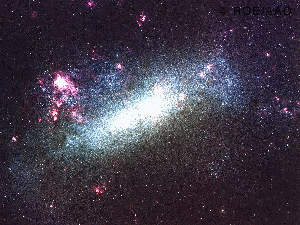Large Magellanic Cloud

The Large Magellanic Cloud (LMC) is one of the two Magellanic Clouds – dwarf irregular galaxies – visible in the southern hemisphere, that orbit the Milky Way Galaxy; it spans 8° of the sky in Dorado and Mensa. The LMC is about 20,000 light-years in diameter, has a visible mass of about one-tenth that of our own galaxy, and, at a distance of some 180,000 light-years, was long considered to be the nearest external galaxy before losing that distinction to the Sagittarius Dwarf Elliptical. It displays a noticeable bar of stars, some of which, including S Doradus, are extremely luminous; from the ends of the bar project a weak spiral structure.
The LMC is rich in a variety of diffuse nebulae, including the spectacular Tarantula Nebula, planetary nebulae, open clusters, globular clusters, and so-called blue populous clusters, which resemble compact, young globulars and are of a type unseen in our own galaxy. An absence of intermediate-age clusters suggests that the LMC has experienced early and late bursts of star formation. The LMC was also the site of supernova 1987A – the nearest observed supernova since that recorded by Kepler.
| apparent magnitude | 0.1 |
| angular size | 650' × 550' |
| distance | 179,000 light-years |
| position | Dec -69° 45'; RA 5h 23.6m |


